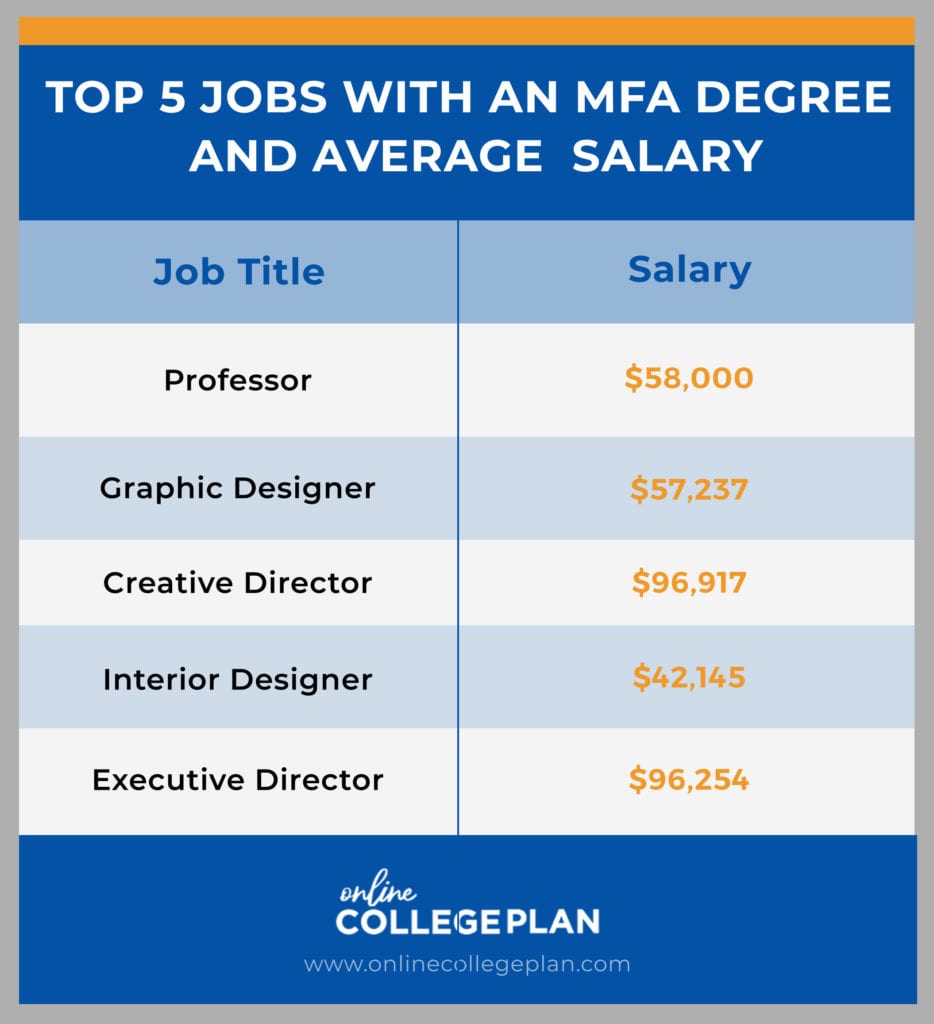What Is an MFA Degree?
Find your degree

For those interested in becoming a professional artist, earning an MFA may the best choice. For those who dance or sing or play the piano or draw or write or act or do any of the other myriad of performing arts, they will most likely blossom in an MFA program. MFA programs allow individuals to be surrounded by others who enjoy the same field of art. Being in classes with teachers dedicated to the visual and performing arts will bring out the best of one’s talents. The MFA program will be an intensive experience in which you will be encouraged and expected to articulate your personal artistic credo. You will be given numerous opportunities to polish your innate skills while learning from experts in the field. You will learn and grow among a cohort of similarly motivated artists. In this article, we have posed questions that you may have about an MFA degree, and the answers we provide may help you to decide how best to use all the zeal that is within you for performance and for the arts.
What does MFA stand for?
MFA stands for master of fine arts, a professional, terminal degree based in the performance of an art form. These art forms include any art that can be exhibited, such as dance, creative writing, music, and theater. Visual arts qualify as fine arts and include both “plastic arts,” which produce an object, and modern visual arts, which use technology and include photography, filmmaking, video, and architecture. The MFA is similar in social stature to the MBA, or master of business administration, in that it can set off a second, more intensive stage in a professional career.
As a type of college achievement, this advanced degree probably came into being in 1940 when the first students enrolled in the University of Iowa’s fledgling MFA program. The program is now 80 years old, and is named the Iowa Writers’ Workshop. Some notable graduates (to name only a few) include Raymond Carver, Bharati Mukherjee, Flannery O’Connor, John Irving, Rita Dove, Ann Patchett, Curtis Sittenfeld, Alan Gurganus, Robert Bly, and Justin Cronin.

What types of specializations are there with an MFA degree?
MFAs are offered for most aspects of performing, literary, or visual arts. The vast majority of online MFA programs are in writing, but there are outliers in interior design and visual art. Without repeating the areas that are mentioned above, here is a partial listing of the many specializations available for study in the realm of fine arts, under the umbrella of an MFA: painting; drawing; sculpture; ceramics; printmaking; design; interior design; digital cinema production; community arts; fibers; glass; metals; jewelry; criticism and curatorial practice; emergent media; creative inquiry; art criticism and writing; documentary studies and production; art conservation; and graphic and interactive design. The world of fine and performing arts is changing so rapidly that by the time you have filled out your application to an MFA program, several other specializations will likely have been created.
What are the best online MFA programs?
The best online MFA program will be the one in which you succeed at polishing your skills, and the elements of the program will come to fruition in your receiving a diploma at the end. No matter which MFA program you choose, you should research your list of likely schools with definite requirements in mind. Uppermost on your agenda will be flexibility, so that you can schedule your life and your work with relative peace of mind and thus be able to concentrate on performing well in your classes. You will want to look for faculties with professors who have practiced the art you wish to study and, perhaps, are still practicing it. You will also be happier if you can locate an MFA program that excites you when reading about it or when speaking to a representative. You’ll recognize the feeling when it happens.
The online programs detailed in the paragraphs below present programs that will appeal to a wide range of fine arts performers. If reading about these programs serves only to whet your appetite to learn more and to explore MFA programs at colleges and universities on your own, then it will have served its purpose. Keep in mind that, to date, the most represented art form in MFA programs that are online is writing. In the future, more and more of the performing and visual arts may slip from the only-in-the-traditional-classroom category and will come to be taught virtually.

Drexel University offers three specializations in the online master of fine arts: creative writing, screenwriting, and fiction writing. The program is low-residency, with only three required residencies, one being on Drexel’s campus in Philadelphia. During one of these residencies, fiction writers will meet in New York with agents, editors, and publishers, and screenwriters will meet in Los Angeles with agents, producers, and directors. The curriculum also places an emphasis on pedagogy.
Brenau University’s MFA in interior design prepares you to teach at the college level. Courses include historical preservation and environmental issues, textiles for interior design, commercial office design, building codes and regulations, thesis (I, II, and III), and portfolio presentation. Preference is shown to applicants with a minimum 3.0 GPA, professional work experience, National Council of Interior Design Qualification, and a bachelor’s degree in Interior Design from an institution accredited by the Council for Interior Design Accreditation.
Southern New Hampshire University has an online MFA in creative writing that requires no residency and focuses on all genres of fiction. At graduation, you will leave the program with a complete and revised novel in the genre that you choose. Virtual classes are asynchronous and available 24/7. You may transfer in up to 12 graduate credit hours. To apply, submit a twenty-page writing sample, which may be a novel excerpt, a story or stories, and an essay or essays, along with two letters of recommendation from people who can objectively assess your ability to work independently and the likelihood of your succeeding in an MFA program.

Albertus Magnus College’s online MFA program is a low residency degree in writing with three tracks: poetry, fiction, and creative non-fiction. Three intensive, online workshops are held each semester, and you will graduate with a portfolio of work that is publishable. If you choose the blended class format, you will meet in class (on the campus in New Haven, Connecticut) one night per week, but all other meetings will be virtual. The application process calls for a 750-1,000 word essay that details “The Writer’s Journey,” your personal reflections on the writer’s craft.
The University of Houston Victoria offers an MFA in creative writing that focuses on creative writing or creative writing–applied literary translation. The low-residency online program is 36 credit hours. Admissions asks for a 20-30 page sample of creative writing. The thesis you produce before graduation will be a book-length manuscript of literary merit. The creative writing curriculum includes workshops in writing creative nonfiction, poetry, and fiction, and each one may be taken up to four times. The applied literary translation curriculum includes international publishing.
The University of Nebraska Omaha’s online MFA in writing boasts six available tracks: fiction; creative nonfiction; poetry; playwriting; screenwriting; and young adult. The low-residency, 60-credit hour program blends four 16-week long, at-home semesters with five ten-day residencies that are patterned after conferences. Students are paired with a mentor who is a practicing writer. Up to 18 credit hours may be transferred in. The program emphasizes a flexible schedule of writing, guided readings, and critical response.

How long does it take to obtain an MFA degree?
Today’s MFA programs typically require two to three years of study after the bachelor’s degree. Most programs will extend the program beyond that, in a reasonable fashion, in case a student encounters difficulty. At the end of the program, students will be expected to demonstrate the culmination of their skills and knowledge in an exhibition or a performance.
How expensive is an MFA degree?
An MFA program will often confer graduate assistantships upon incoming students to offer students financial compensation for teaching introductory-level classes in their field. This can subsidize the degree to a certain extent. And the fine arts are usually thick with scholarship and grant opportunities. As points of reference, and using the six schools detailed in the above list of best online MFA programs, the cost per credit hour may range from $500 to $710. These figures are for out-of-state residents; in-state costs are lower.
Who should obtain an MFA degree?
Since an MFA is performance-based, those who are drawn to perform or to create will certainly do better in an MFA program than those who are not as driven to perform or create. The alternative degree program is the MA, which is an avenue to scholarship and teaching. If you, as an MFA student, are fully aware that an artistic career is not guaranteed to lead to extreme wealth–unless you are very lucky–then this path may be the correct one for you. The cliched image of the aspiring actor who moonlights as a waiter is also true enough, so that MFA students may reasonably expect to support their love of performing with day jobs that might be far removed from what they are learning and practicing for arts classes. Personal satisfaction will be the goal rather than great wealth.

A popular movie from the 1960s addressed “The Loneliness of the Long-Distance Runner,” but those who head off by themselves into the world of performance art can experience loneliness also. Another intangible and priceless benefit of enrolling in an MFA program is the network of friends, teachers, and mentors who will encourage, observe, and guide your career. These people will likely become significant along your path to performance and success. The portfolio of work you accomplish will serve as the “portable record” of all that you gained from the MFA process.
Just as a kind of “you-should-know-these-facts” digression, it is intriguing to learn about some famous people who once felt–like you, perhaps–that they should obtain an MFA. The actor James Franco, for instance, earned an MFA in creative writing from Columbia University quite recently, and the actresses Angela Bassett and Sigourney Weaver graduated from Yale University with MFAs in drama.
What are the career options for those with MFA degrees?
Graduates with an MFA in writing are likely to be in demand in every area of communication and administration. Other professional venues are radio, television, advertising agencies, newspapers, magazines, and even a free-lance business of your own. MFA in acting grads may opt to begin close to home, as with community or college theater, and then move on to Broadway or Hollywood. Those with an MFA in art, especially in the area of graphic design, will be welcomed by advertising and marketing departments as well as non-profit organizations or companies.
MFA holders in every field of visual or performing art will always have an advantage in finding a teaching position, and many MFA programs construct their curricula with this outcome in mind.
What are the admission requirements for an MFA degree?
The admissions process for an MFA sets it apart from other degrees in its requirement of a portfolio of previous work for visual and literary artists, or an audition, or series of auditions, for performers of various stripes. Your portfolio of work in your field of study or your audition will be expected to demonstrate a professional level of skill. Some programs may call for an MFA in the same field as one’s undergraduate degree, but others do not. Your transcripts must reveal a minimum 3.0 GPA, and you will submit letters of recommendation and a statement of purpose. In general, GRE scores are not required for an MFA.

What are the fine arts associated with an MFA?
In addition to the categories listed above in other answers, it is possible to earn an MFA degree in opera, jazz, musical theater, several kinds of writing, computer art, street art, conceptual art, illustration, and even bookmaking. If you can envision working/doing/performing or creating an art (and, in some cases, a craft), an MFA can set you on your way to a new and better skill level in the art you love.
Related Articles:
What is a Liberal Arts College?
